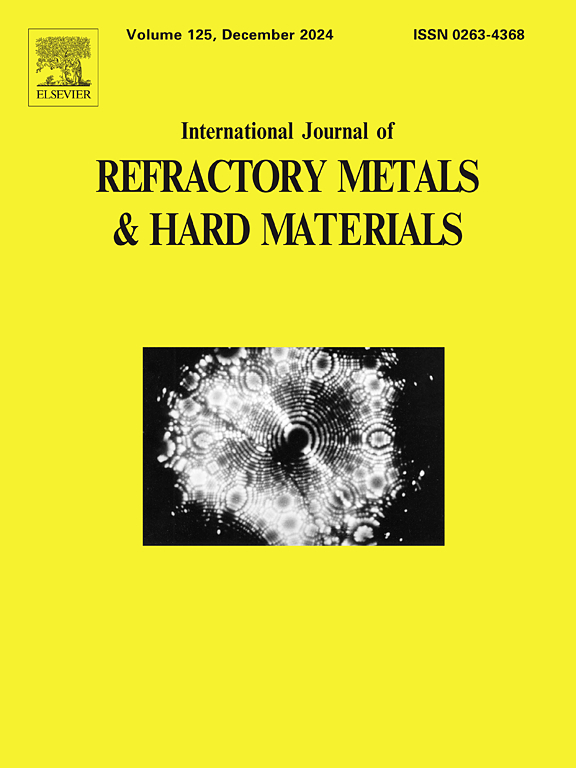Improving Cu-network structure of W@20Cu composites by ultrasonic-assisted particles rearrangement
IF 4.2
2区 材料科学
Q2 MATERIALS SCIENCE, MULTIDISCIPLINARY
International Journal of Refractory Metals & Hard Materials
Pub Date : 2025-02-20
DOI:10.1016/j.ijrmhm.2025.107101
引用次数: 0
Abstract
This work reports a simple method to improve the connectivity of Cu-network structure in W@20Cu composites with Cu-coated W powders. W@20Cu composites, featuring an interpenetrating W and Cu network structure, were sintered via an ultrasonic-assisted reorganization process of W@20Cu microcapsules. The rearrangement process of ultrasonic vibration in these microcapsules was investigated through numerical simulation. As-sintered W@20Cu composites after ultrasonic-assisted filling of W@20Cu microcapsules exhibit uniform microstructure with a Cu enrichment ratio 54.5 % lower and hardness uniformity 45 % better than the counterparts without ultrasonic vibration, as well as the high tensile strength of 316 MPa and the compressive strength of 448 MPa. This processing strategy can realize precise control of Cu-network structure without increasing the process complexity, providing useful experiences and references for fabricating high-performance W![]() Cu composites.
Cu composites.
超声辅助粒子重排改善W@20Cu复合材料cu网络结构
本文报道了一种提高W@20Cu复合材料中cu网络结构连通性的简单方法。采用超声辅助重组法制备W@20Cu微胶囊W@20Cu复合材料,该复合材料具有W和Cu互穿的网状结构。通过数值模拟研究了超声振动在微胶囊中的重排过程。超声辅助填充W@20Cu微胶囊后的W@20Cu复合材料微观结构均匀,Cu富集率比未超声振动时降低54.5%,硬度均匀性提高45%,抗拉强度达到316 MPa,抗压强度达到448 MPa。该加工策略在不增加工艺复杂度的前提下实现了cu网络结构的精确控制,为高性能钨铜复合材料的制备提供了有益的经验和参考。
本文章由计算机程序翻译,如有差异,请以英文原文为准。
求助全文
约1分钟内获得全文
求助全文
来源期刊
CiteScore
7.00
自引率
13.90%
发文量
236
审稿时长
35 days
期刊介绍:
The International Journal of Refractory Metals and Hard Materials (IJRMHM) publishes original research articles concerned with all aspects of refractory metals and hard materials. Refractory metals are defined as metals with melting points higher than 1800 °C. These are tungsten, molybdenum, chromium, tantalum, niobium, hafnium, and rhenium, as well as many compounds and alloys based thereupon. Hard materials that are included in the scope of this journal are defined as materials with hardness values higher than 1000 kg/mm2, primarily intended for applications as manufacturing tools or wear resistant components in mechanical systems. Thus they encompass carbides, nitrides and borides of metals, and related compounds. A special focus of this journal is put on the family of hardmetals, which is also known as cemented tungsten carbide, and cermets which are based on titanium carbide and carbonitrides with or without a metal binder. Ceramics and superhard materials including diamond and cubic boron nitride may also be accepted provided the subject material is presented as hard materials as defined above.

 求助内容:
求助内容: 应助结果提醒方式:
应助结果提醒方式:


